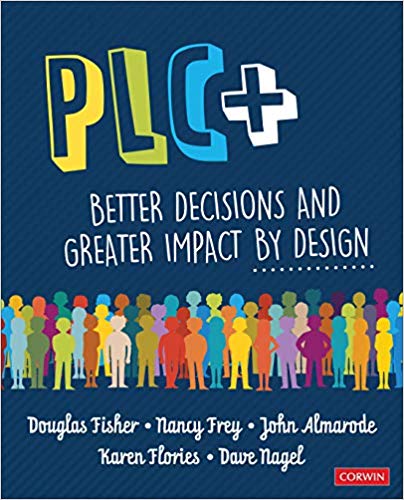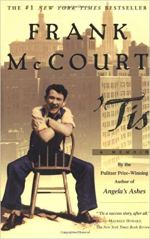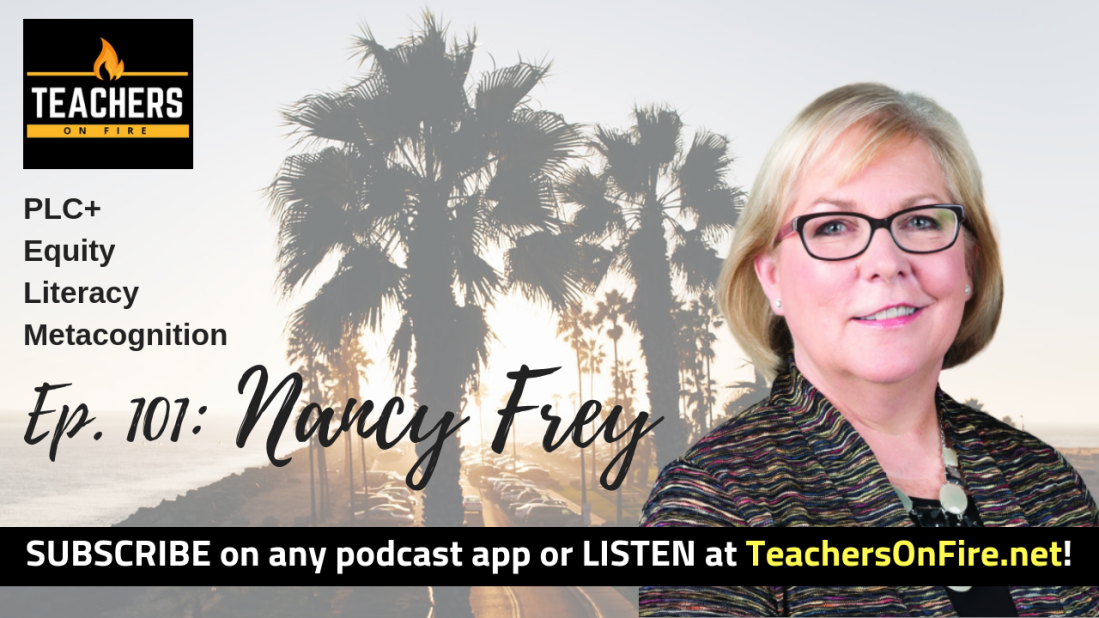Meet Nancy Frey
NANCY FREY is a Professor of Educational Leadership and Literacy at San Diego State University at the graduate and doctoral levels. She’s also an instructor at Health Sciences High and Middle College, a secondary charter school which she co-founded 13 years ago with Doug Fisher and others. The school runs from grade 8-12 with about 700 students, and her teaching practice there helps to make sure that the ideas she advocates for in her research and writing actually work in practice.
Nancy has also authored or co-authored a number of books, including PLC+: Better Decisions and Greater Impact by Design.
Rocked By a Hurricane
When asked about a low moment, Nancy thinks back to the time she spent teaching in south Florida. One year, Hurricane Andrew hit the area just days before school opened. The storm exacted a heavy toll on the communities across the region, causing her district to expand very quickly due to damaged and destroyed schools in nearby counties. More significantly, almost every additional student came into the district with significant emotional trauma.
It was a difficult year that even made Nancy challenge her place in the profession, partly because she felt so unprepared to offer the guidance, comfort, and support that her learners truly needed while also promoting their academic growth and development. Thankfully, with a mix of inner commitment and support from colleagues, Nancy remained an educator, and she now credits this year with giving her valuable experiences and perspectives regarding trauma-informed education.
What is Visible Learning?
Visible Learning is the terminology used to refer to the research engineered by John Hattie, who used a meta-analysis to review hundreds of academic studies in an effort to determine what truly works in education. From this research, he and his team have created an index of what he calls effect sizes: how do different interventions positively or negatively affect learning outcomes?
With close to 300M students represented in these studies, this research can say with authority what works and what doesn’t in education. Supported by the groundbreaking research and resources from Visible Learning, schools and districts no longer need to guess about where to apply their energies.
Taking Your PLC to the Next Level: PLC+
 In PLC+: Better Decisions and Greater Impact by Design, Nancy and Doug Fisherlook at the power behind professional learning communities and apply the latest research to suggest ways to take PLCs to the next level. The ‘+’ in PLC+ is you – what it is that you bring to your learning community.
In PLC+: Better Decisions and Greater Impact by Design, Nancy and Doug Fisherlook at the power behind professional learning communities and apply the latest research to suggest ways to take PLCs to the next level. The ‘+’ in PLC+ is you – what it is that you bring to your learning community.
The book organizes the PLC+ process around five key questions:
- Where are we going? What is our destination?
- Where are we now? Take a situational assessment.
- How can we move learning forward?
- What did we learn today? How are we enriching ourselves as a PLC so that we can continue the work that we’re doing?
- Who benefited and who did not? This is the essential question of equity.
These questions are grounded in four universal values:
- Equity,
- Higher expectations,
- Activation, and
- Individual and collective efficacy – belief in our ability to effect change.
In Nancy’s view, PLCs and our perceptions of them have tended to become more restrictive over time. Twenty-first century manifestations of PLCs should actually integrate well with PLNs in the sense that every member of a PLC must remain engaged in a PLN in order to further support their own learning and allow them to better contribute to their PLC. Other strategies like micro-learning and learning walks must be parts of robust PLCs as well.
Building Literacy Through the Tools of Metacognition
When I asked Nancy for some quick advice for the literacy classroom, Nancy pointed back to John Hattie. Do you know your impact? Do you know when your students have learned something? These are the questions that must drive everything we do in literacy and throughout K-12 education.
In the literacy classroom we must also ask ourselves how we are bringing students into the learning. This goes beyond ensuring content relevance – it means that students must understand WHAT they are learning, WHY they are learning it, and HOW they will know that they have been successful in learning it. Learning intentions and success criteria must be made clear to learners in every lesson, and when it comes to English classes, progress tends to be incremental – they’re generally not leaving a 30-minute lesson with a brand new skill.
With that in mind, we must give students the tools of self-assessment: how can students look at their own work and gauge their own growth and progress? How can we equip our learners to critique the work of peers? For English teachers looking to empower their students in this area, Nancy points to a few titles including Developing Assessment-Capable Visible Learners, Grades K-12: Maximizing Skill, Will, and Thrill.
Other Areas That Are Setting Nancy on 🔥 in Education
Nancy is very intrigued by the ways that technology is being effectively embedded and woven into instruction today. She points to the ways that our views of technology in education have changed from past decades: from computer lab to essential tool. Technology tools can be a double-edged sword, however, because technology itself is no assurance of learning, and in fact, we still don’t fully understand how technology changes the ways in which students learn.
Today, high school students walk around with computers in their pockets – devices more powerful than the computers that first sent spaceships to the moon. On the one hand, these phones can be the bane of a teacher’s existence, but on the other hand, educators must better harness this technology in order to advance learning.
The questions around phones and phone policy in schools are not easy ones to answer, but we must continue to struggle and learn in this area. (Editor’s Note: Check out my exploration of this issue at On Schools and Cell Phones.)
Is Handwriting an Essential Literacy Skill?
Should pens and pencils remain part of the writing classroom? Nancy says that students should be exposed to a wide continuum of learning experiences. Evidence also suggests that the motor functions involved in writing seem to inform the abilities of young learners to break the code (decode letters and words). Young children should know how to engage in print and cursive, and older students should at least have the capacity to sign their name. Nancy shares her experience from a recent class of seniors – many of whom struggled to sign a document in cursive. Yes, young learners should learn how to keyboard, and voice-to-text will continue to change the nature of composition.
Professional Goals for This Year
Nancy’s annual and evergreen goal is to ask: How can I be a better teacher this year? If that isn’t a question you’re asking, Nancy chuckles, it may be time to look for a new profession. Lately, Nancy has been writing about the intersection between teacher credibility and collective efficacy and the ways in which these two constructs can support and promote the other.
Nancy is also intrigued by the ways that students learn about their own learning through practice tests. Do students know what they’re learning and what they’re not learning?
Personal Passions Outside of Education
One activity that ignites Nancy’s passions and brings her alive as a human being when she leaves the halls of education is her work with kettlebells. She has participated in functional fitness workouts with kettlebells and the kettlebell community for the last six or seven years, and she is consistent. “Strong is the new skinny,” she says. She hits her gym about six days out of seven, and it’s formed a big part of her personal wellness.
A Productivity Habit: Meditation
The personal habit that has been making the biggest difference for Nancy in the productivity space is meditation. She meditates for 15 minutes after waking up each morning, and she finds that she is more productive as a result. It’s time to be quiet, to be mindful, to be self-aware, and to slow down. Nancy uses the Calm app and is competitive enough that her personal streaks are important to her, and she even appreciates the badges earned over time.
Voices & Resources That Inspire Nancy’s Practice
On Twitter, Nancy is a big fan of the #G2Great hashtag and regular Twitter chat.
As far as edtech tools go, Nancy loves what smartpens do for learners and learning in the classroom. There are so many uses for smartpens that fit within UDL and increase equity for all learners.
 Nancy’s all-time favorite read is Tis: A Memoir by Frank McCourt. This classic describes the life of an English teacher in New York City from an earlier time.
Nancy’s all-time favorite read is Tis: A Memoir by Frank McCourt. This classic describes the life of an English teacher in New York City from an earlier time.
In the world of podcasts, Nancy’s pick is Disgraceland, which unpacks the spectacular missteps and disasters that have followed countless pop music stars. It’s a guilty pleasure and Nancy can’t get enough of it.
On YouTube, Nancy is a big fan of the resources shared on the Teaching Channel. Get to know the Teaching Channel on Twitter @TeachingChannel.
Yes, Nancy does occasionally find time for Netflix! One of her favorite series of late was Russian Doll.
We sign off on this conversation, and Nancy gives us the best ways to follow her and connect online. See below for details!
You can connect with Nancy …
- On Twitter @NancyFrey
- On her website at https://www.fisherandfrey.com/
Connect with the Teachers on Fire podcast on social media!
- On Twitter @TeachersOnFire
- On Instagram @TeachersOnFire
- On Facebook Teachers On Fire
- On LinkedIn Tim Cavey
- On The Teachers on Fire Magazine on Medium
- On YouTube: Teachers on Fire
Song Track Credits
- Intro: Stand Up (by Mike Cosmo — license purchased at https://taketones.com/)
- Outtro: Bluntedsesh4 (by Tha Silent Partner, courtesy of FreeMusicArchive.org)

I can still remember the session I took with Nancy last year in Richmond, BC. It was awesome! I’m also intrigued by Nancy’s Disgraceland podcast recommendation.
LikeLike
Yeah I’m still sad that I missed Nancy that day. Connie Hamilton was a great help on the Math side of things but my heart is in literacy. Thanks for the comment, Jordan!
LikeLike